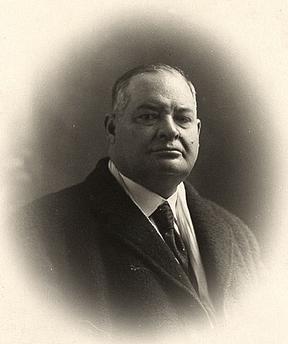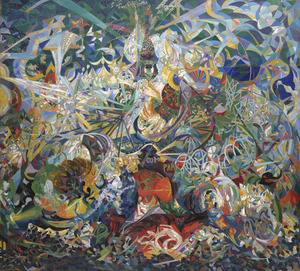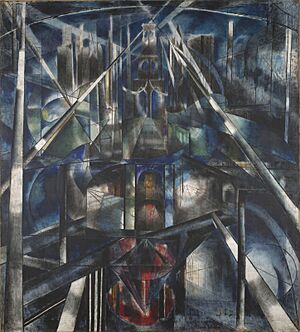Joseph Stella facts for kids
Quick facts for kids
Joseph Stella
|
|
|---|---|
 |
|
| Born | June 13, 1877 Muro Lucano, Italy
|
| Died | November 5, 1946 (aged 69) |
| Nationality | American |
| Education | Art Students League of New York, William Merritt Chase. |
| Known for | Painting |
| Movement | Precisionism, Futurism |
Joseph Stella (born Giuseppe Michele Stella, June 13, 1877 – November 5, 1946) was an Italian-born American Futurist painter. He is best known for his paintings of industrial America. His images of the Brooklyn Bridge are especially famous. He was also part of the American Precisionist art movement from the 1910s to the 1940s.
Contents
Joseph Stella: An American Futurist Painter
Early Life and Artistic Journey
Joseph Stella was born into a middle-class family in Muro Lucano, a village in Italy, on June 13, 1877. His grandfather and father were lawyers. In 1896, he moved to New York City to study medicine, like his older brother. At this time, he changed his name from Giuseppe to Joseph.
However, he soon left medicine to study art. He attended the Art Students League of New York and the New York School of Art. He learned from a teacher named William Merritt Chase. His first paintings showed scenes of city life, similar to the style of Rembrandt.
Stella was a very skilled artist, especially at drawing. He drew throughout his career. He started as a realist artist, focusing on the lives of immigrants. From 1905 to 1909, he worked as an illustrator. He published his realistic drawings in magazines. He would often walk the streets, sketching people and scenes. In 1908, he was asked to create a series of drawings about industrial Pittsburgh. These were later published in The Pittsburgh Survey.
Discovering Modern Art in Europe
Stella returned to Italy in 1909. He was not happy in America at first. He felt he needed to be back in his home country. This trip to Europe was important for his art. He discovered Modernism, which greatly shaped his unique style. His new style used strong colors and bold, sweeping lines.
By 1911, he moved to Paris, France. He felt that Italy's old Renaissance art made it hard for new painters. In Paris, he found a vibrant art scene. He wrote that Fauvism, Cubism, and Futurism were "in full swing." He felt it was the perfect place for an artist who was curious and open to new ideas.
In Paris, Stella visited the salon (a gathering place) of Gertrude Stein. There, he met many other painters. He met Umberto Boccioni and became friends with Gino Severini. He started to use Futurist ideas in his art. He was also interested in the structured art of the Cubists and the bright colors of the Fauves.
Back in New York: Capturing the City
Stella returned to New York in 1913. This time, he was ready to give America another chance. He joined art groups led by Alfred Stieglitz and Walter Arensberg. He also became close friends with other artists like Albert Gleizes and Marcel Duchamp. These connections gave him many chances to be around other creative people and see new art.
In 1913–14, he painted Battle of Lights, Coney Island. This is one of the earliest and most important American Futurist artworks. He also took part in the famous Armory Show of 1913. This show encouraged him to try out more modern art styles. His paintings Der Rosenkavalier (1914) and Spring (The Procession – A Chromatic Sensation) (1914–16) are examples of his colorful abstract art.
After the Armory Show, Stella became well-known in the New York art world. Some traditional critics did not like his modern art. But younger, more adventurous artists found his work fascinating. His painting caused a big stir in the art world.
In the 1920s, Stella became very interested in the geometric shapes of buildings in Lower Manhattan. His paintings from this time combined ideas from Cubism and Futurism. In Brooklyn Bridge (1919–20), he showed his fascination with the strong lines of the bridge. He used the bridge as a symbol of modern life. His paintings of the bridge show its diagonal cables sweeping downwards, full of energy. These dynamic images show the excitement of modern life. But for Stella, the bridge also represented strength and stability.
Another famous painting is New York Interpreted (The Voice of the City) (1922). This is a huge work with five panels, almost twenty-three feet long. It looks like a religious altarpiece, but instead of saints, it shows bridges and skyscrapers. This painting shows the idea that industry was becoming as important as religion in modern life. This painting is now in the collection of the Newark Museum.
Later Artworks and Legacy
In the 1930s, Stella worked on the Federal Art Project. He also traveled to Europe, North Africa, and the West Indies. These trips inspired him to try many different art styles. He moved from realism to abstraction and even surrealism.
However, his later works were sometimes hard for people to understand. He no longer fit into one specific art movement. His art became more personal and unique. For example, Tree of My Life (1919) is very detailed and dramatic. His many paintings of flowers were almost surreal, but they were too lush to be part of the Surrealist movement.
Stella's strong drawing skills are clear in all his artworks. Today, he is especially admired for his portraits drawn on paper using silverpoint. Many of these are from the 1920s. His drawings of famous people like Walt Whitman and Marcel Duchamp show his amazing skill with lines and details.
A lesser-known part of Stella's work is his collages from the 1920s. These were made from discarded paper, wrappers, and other bits of city trash. He often added paint strokes to them. These collages show his interest in the hidden, unnoticed parts of city life. They were similar to the art of German artist Kurt Schwitters and the Dada movement, which Stella liked.
By the late 1930s, Stella's art received less attention. His personality sometimes pushed old friends away. His art style also no longer seemed to fit the times. His health declined in the early 1940s. He was diagnosed with heart disease and suffered from anxiety. Joseph Stella died from heart failure in 1946. He is buried in Woodlawn Cemetery in the Bronx, New York City.
Famous Artworks You Can See
Many of Joseph Stella's important works are in public art collections:
- Pittsburgh Factory Scene (1908–1918): Minneapolis Institute of Art, Minneapolis
- Battle of Lights, Coney Island, Mardi Gras (1913–14): Yale University Art Gallery
- Battle of Lights, Coney Island (1913–14): Sheldon Museum of Art, University of Nebraska–Lincoln
- Der Rosenkavalier (1914): Whitney Museum of American Art
- Pyrotechnic Fires (1919): Museum of Fine Arts Houston
- Brooklyn Bridge (1919–20): Yale University Art Gallery
- New York Interpreted (The Voice of the City) (1920–22): Newark Museum
- Factories (1920): Museum of Modern Art
- The Birth of Venus (1922): Salisbury House
- By-Product Plants (1923–26): Chicago Art Institute
- The Amazon (1925–26): Baltimore Museum of Art
- The Virgin (1926): Brooklyn Museum
- Tree, Cactus, Moon (1927–28): Reynolda House Museum, North Carolina
- American Landscape (1929): Walker Art Center
- Lotus (1929): Hirshhorn Museum
- Flowers, Italy (1930): Phoenix Art Museum
- Smoke Stacks (1935): Indiana State University Art Collection
- Old Brooklyn Bridge (1941): Museum of Fine Arts, Boston
Art Market Success
On November 13, 2018, one of Stella's paintings, Tree of My Life (1919), sold for a record price. It was sold at Christie's New York for US$5,937,500. This was the highest price ever paid for a work by Joseph Stella at a public auction.
Images for kids
-
Man Ray, 1920, Three Heads (Joseph Stella and Marcel Duchamp)
See also
 In Spanish: Joseph Stella para niños
In Spanish: Joseph Stella para niños




